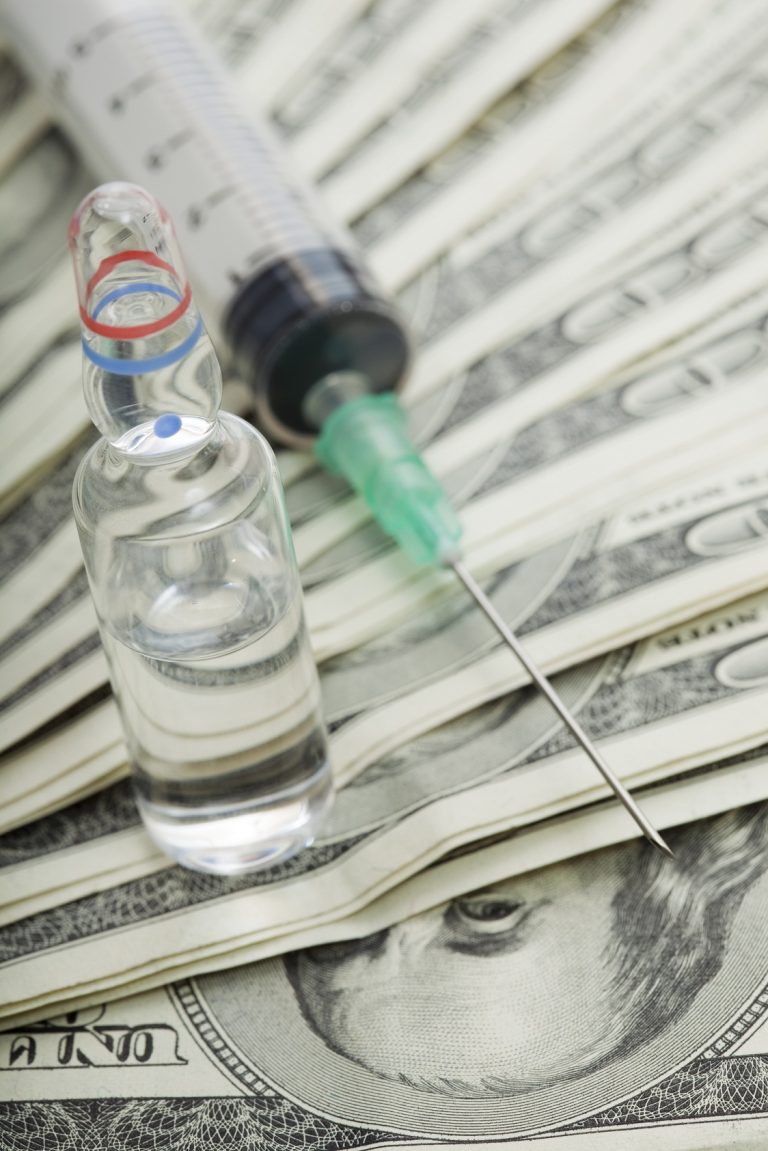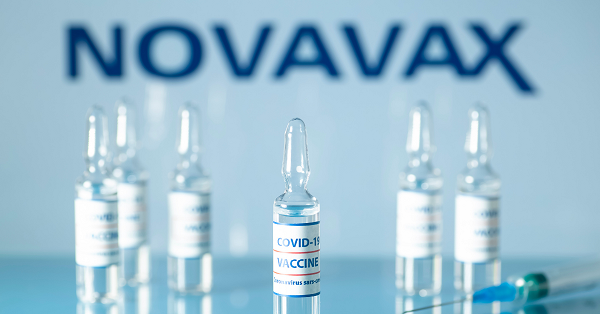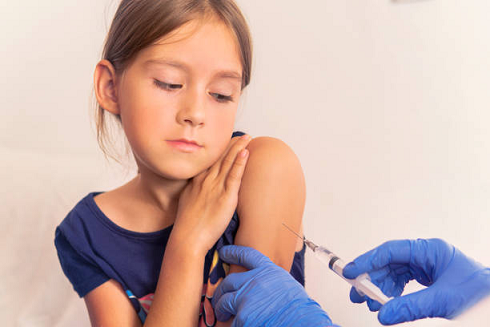It is no secret that huge conflicts of interest exist between vaccine promoters and vaccine makers. Pediatrician and vaccine developer Paul Offit, for example, who is one of the nation’s leading promoters of mandatory use of government recommended vaccines, holds a $1.5 million research chair at Children’s Hospital in Philadelphia, funded in part by Merck.1 Julie Gerberding left her post as Director of the Centers for Disease Control and Prevention (CDC), where she oversaw the creation of national vaccine policies, to head Merck vaccines.2 Former Texas governor Rick Perry recommended state-wide inoculation of all 11- and 12-year-old girls with Merck’s Gardasil vaccine after his chief of staff left to work at Merck.3 4
Just as disturbing are the millions of dollars that officials at the National Institutes of Health (NIH) dole out to academic institutions and vaccine manufacturers to improve vaccine technology, find new, lucrative markets and boost vaccine marketability—functions that guarantee the profitability of corporations, but do not always ensure the well being of taxpayers, the public and patients.
Once upon a time, before passage of the Bayh-Dole Act by Congress in 1980 and the push for lucrative “technology transfer” business arrangements between federal agencies and for-profit corporations, inventions developed with federal funding were owned by the U.S. Government and not industry. Today, taxpayer-supported research to develop new drugs and vaccines is voraciously patented by universities and drug companies for outsized Wall Street profits when the research rightfully belongs to taxpayers.5
Development of the human papillomavirus (HPV) Gardasil and Cervarix vaccines is a case in point. The initial research was funded by the NIH, National Cancer Institute, University of Rochester, Georgetown University and the University of Queensland, which licensed them to Merck and GlaxoSmithKline.6 7 In 2015, Merck made $1.9 billion on its Gardasil franchise.8
Soon, aggressive domestic and overseas marketing of the expensive HPV vaccines began, even as the vaccines themselves got poor marks for both safety and effectiveness. In 2006, consumer advocacy groups had protested the FDA’s fast tracking of Gardasil vaccine to licensure, citing inadequate safety data.9 Reports of sudden collapse/fainting (syncope) and serious neurological and immune system problems after Gardasil vaccinations emerged immediately after the vaccine was licensed.10
For example, in just one year between Sept. 1, 2010 and Sept. 15, 2011, there were thousands of Gardasil vaccine reaction reports of seizures, paralysis, blindness, pancreatitis, speech problems, short term memory loss, Guillain-Barré Syndrome and 26 deaths filed in the FDA’s Vaccine Adverse Event Reporting System (VAERS).11 12 In 2016, judges in India’s Supreme Court demanded answers after children died during a trial of the HPV vaccines Gardasil and Cervarix.13
This is how investigative reporter Jeanne Lenzer cast the problems with HPV vaccines in 2011:14
There are better ways to spend the billions of dollars currently being spent on HPV vaccines. First, we already have a pretty terrific way to prevent most cervical cancer deaths, and it’s called the Pap smear. Since poor women are less likely to get Pap smears and more likely to die from cervical cancer, we could start by extending medical services to them. Second, many oral cancers are caused by smoking, and men and women who smoke are more likely to die of oral and cervical cancer, so we could invest in smoking cessation efforts.
As HPV vaccine safety and efficacy problems persisted, the NIH acknowledged the vaccine was widely shunned by mothers of both boys and girls, adolescents and many in poor and ethnic communities. But that did not stop the NIH from continuing its subsidy of the vaccine industry with tax dollars, this time helping with actual marketing.
In 2013, the NIH gave half a million dollars to the University of Texas SW Medical Center Dallas to try to “identify an optimal and feasible self-persuasion intervention strategy to promote adolescent HPV vaccination in safety-net clinics,” also known as sell more vaccines.15 Nor was that the only marketing grant NIH gave to the university to aggressively market HPV vaccines.
The University of Texas El Paso received $422,716 from the NIH to do similar free marketing and “pilot test a future intervention to promote adoption of the HPV vaccine in the Latino community” while “considering cultural factors.”16 In 2013/2014, Yale University received $390,389 from the NIH to “identify and describe barriers to HPV vaccination completion among lower income racial and ethnic minorities” and “generate ideas for future interventions that will be culturally relevant and have the greatest potential for impact.”17
The National Vaccine Advisory Committee (NVAC), overseen by the National Vaccine Program Office in the U.S. Department of Health and Human Services (DHHS), takes their job of providing free marketing for the vaccine industry one step further—it recommends enlisting health care providers in the sales force.18 It cautions providers to not miss “clinical opportunities to administer HPV vaccination,” which are defined as visits to a provider in which at least one other recommended adolescent vaccination is received but not the HPV vaccine. The NVAC also recommends “office strategies, such as reminder-recall systems and the distribution of information and educational materials from provider professional organizations” to sell the HPV vaccine to patients and suggests that pharmacists get involved. CDC programs offer incentives/bonuses to “motivate providers to develop more effective immunization delivery systems and ultimately improve immunization coverage levels.”19
The NIH also gives money to drug companies making and marketing vaccines to simply improve their bottom line, government largesse that would be unthinkable in other industries. In 2013, NIH bestowed almost $2 million on Advanced Bioscience Laboratories, Inc. to “facilitate the development and introduction of new vaccines” including product development, toxicology studies, technical and facility audits and regulatory support appropriate for submission to the FDA.20
If private industry keeps the profits, why should government fund vaccine development and marketing operations?
In 2012, Advanced Bioscience Laboratories received $1,052,178 from the NIH to develop “promising products when such products emerge from investigator-initiated research studies.”21 The same year, NIH gave $2,120,235 to California University San Diego at La Jolla to “discover, characterize, and support preclinical testing of new adjuvant candidates [for vaccines] based upon triggering of the human innate immune system.”22
Between 2009 and 2014, NIH also gave a cool million to Alexander Biodiscoveries, LLC for studies “directed at developing new drugs that can combat influenza virus” plus another one million dollars to Corixa Corporation to “discover, characterize, and support preclinical testing of new adjuvant candidates based upon triggering of the human innate immune system.”23 24 Generous grants were also given to Multimeric Biotherapeutics and other biotech companies to improve their profits and marketability of their vaccines on the public’s dime.25
Finally, for years, the National Institute on Drug Abuse (NIDA), part of NIH, has handed millions of dollars to the pharmaceutical industry to develop a vaccine to treat cocaine and meth addiction despite the contention of non-industry recovery experts that addiction is not just a physical disease but an emotional and spiritual one too and, thus, not very amenable to a vaccine or other physical treatment.26 Intervexion Therapeutics, for example, has received grants for several years in a row to develop “a methamphetamine conjugate vaccine.”
While the vaccine industry loves to present itself as “life saving,” addiction vaccines that target a defined population seem more like for-profit designer drugs than vaccines for preventing contagious diseases that affect the broader public. Addiction vaccines also suggest a deep misunderstanding of the process of addiction itself, as most people with drug cravings who want to get high on meth, are unlikely to seek or even accept a vaccine that would “block or slow the rate at which METH enters the brain, [and] shield the user from METH’s rewarding and toxic effects,” as the grant naively reads.27
In funding the marketing of vaccines, improving vaccine makers’ bottom line and soliciting addiction vaccines, the NIH clearly is lavishing taxpayer dollars on an already very profitable vaccine industry.
References:
2 Reuters. Former CDC head lands vaccine job at Merck. Dec. 21, 2009.
3 Rosenberg, M. Mental Health Inc. AlterNet Jan. 8, 2018.
4 Eggen D. Rick Perry and HPV vaccine maker have deep financial ties. The Washington Post Sept. 23, 2011.
5 The University of Arizona. Bayh-Dole Act & University Technology Transfer What’s it mean to me? Tech Launch Arizona Mar. 9, 2014.
6 Padmanabhan S, Armin T, Sampat B et al. Intellectual Property, Technology Transfer and Developing Country Manufacture of Low-cost HPV vaccines – A Case Study of India. Nature Biotechnology 2010; 28 (7): 671–678.
7 Joshi, PP, Roberts, L. Hann, D. NIH’s Role in Developing an HPV Vaccine: A Retrospective Analysis. Portfolio Analysis Poster Meeting. NIH Division of Program Coordination, Planning and Strategic Initiatives (DPCPSI) July 2014.
8 Sagonowsky E. GSK exits U.S. market with its HPV vaccine Cervarix. Oc. 21, 2016.
9 National Vaccine Information Center. Merck’s Gardasil Vaccine Not Proven Safe for Little Girls. NVIC.org June 27, 2006.
10 Debold V, Fisher BL. Human Papillomavirus Vaccine Safety Analysis of Adverse Events Reporting System Reports: Adverse Reactions, Concerns and Implications. National Vaccine Information Center Feb. 1, 2007.
11 Lind, P. U.S. court pays $6 million to Gardasil victims. The Washington Times. December 31, 2014.
12 MedAlerts. The U.S. Government’s Vaccine Adverse Events Reporting System Database. MedAlerts.org.
13 Rosenberg, M. Where Is the Vaccine Safety Grey Area? Epoch Times. Jan. 27, 2017.
14 Lenzer, J. Should boys be given the HPV vaccine? Discover Magazine Nov. 14, 2011.
15 National Institutes of Health. NIH Grant: Developing a self-persuasion intervention promoting adolescent HPV vaccination. Grantome.com.
16 NIH. NIH Grant: Mother-daughter joint decision making to obtain the HPV vaccine. Grantome.com.
17 NIH. NIH Grant: Disparities in HPV vaccine completion: Identifying and quantifying the barriers. Grantome.com,
18 National Vaccine Advisory Committee. Overcoming Barriers to Low HPV Vaccine Uptake in the United States: Recommendations from the National Vaccine Advisory Committee. NCBI June 9, 2015.
19 Centers for Disease Control and Prevention. Four components of AFIX. CDC.gov.
20 NIH. NIH Grant: Task X3: manufacture and characterization services for vaccines and biologics. Grantome.com.
21 NIAID preclinical development support. Federal Reporter.
22 NIH. NIH Grant: Small molecule stimulators of innate immune receptors. Grantome.com.
23 NIH. NIH Grant: Novel anti-viral agents to treat influenza. Grantome.com.
24 NIH. NIH Grant: Novel TLR7/8 agonists as adjuvants for rapid-acting vaccines. Grantome.com.
25 NIH. NIH Grant: Development of a multimeric CD40 ligand vaccine adjuvant. Grantome.com.
26 Ibid.
27 NIH. NIH Grant: A methamphetamine conjugate vaccine: from manufacturing to IND. Grantome.com.













14 Responses
Please make it possible to post info to Facebook
You KNOW Julie Gerberding, Rick Perry, Bill Gates, Paul Offit and all the other EVIL, VILE people who push these vaccinations do NOT vaccinate their own kids because they KNOW how dangerous these vaccines are to the human body. May these people rot in hell someday for what they have KNOWINGLY done!
Couldn’t agree more. There’s a really stupid pediatrician from the local children’s hospital in my state who claimed mercury in vaccines was perfectly safe. I bet she doesn’t even vaccinate her own kids!
I am sure she doesn’t. They have substituted the vaccines now with aluminum instead of mercury which is just as bad or worse. So if they they tell you they no longer use mercury ask them what do they use!!
Unless they die differently than they are living now, I wholeheartedly agree with you. They are trying to control society and are doing a good job of it. These children’s hospitals know exactly what they are doing too. They should look for alternatives to chemo and radiation that tears down the immune system and FIRST of all stop the VACCINES which is linked to the cancers. We are living in a sad and sinful world.
It seems for the most part, very few wanna wake- up.
I believe everything composed made a great deal of sense.
However, what about this? what if you were to create a killer title?
I am not suggesting your information is not good., however suppose you added something that makes people want
more? I mean How NIH Uses U.S. Tax Dollars to Secure Profits for Vaccine Developers and Manufacturers – The Vaccine
Reaction is a little vanilla. You could peek at Yahoo’s home page and watch how they create post titles to
grab viewers to click. You might add a related video or a pic or two to grab readers interested about everything’ve got to say.
In my opinion, it could make your posts a little livelier.
I think that everything typed made a lot of sense.
But, what about this? what if you typed a catchier title?
I am not suggesting your content isn’t good, but what if you added a
headline that grabbed folk’s attention? I mean How NIH Uses U.S.
Tax Dollars to Secure Profits for Vaccine Developers and
Manufacturers – The Vaccine Reaction is a little plain. You might glance at Yahoo’s home page and watch how
they create article headlines to get viewers to
click. You might try adding a video or a related picture or two to grab readers excited about what you’ve written. Just
my opinion, it would make your posts a little
livelier.
Good post. I am dealing with many of these issues as well..
Way cool! Some very valid points! I appreciate you penning this article plus the rest of the
website is also very good.
Great article! That is the type of info that
should be shared across the net. Disgrace on Google for
now not positioning this post higher! Come on over and
talk over with my website . Thank you =)
I got what you mean,saved to my bookmarks, very nice web site.
Deference to article author, some good information.
I think everything published was very reasonable.
But, think on this, what if you were to write a awesome headline?
I ain’t suggesting your content is not good, however what if you added something to possibly grab folk’s attention? I
mean How NIH Uses U.S. Tax Dollars to Secure Profits for Vaccine Developers and Manufacturers – The
Vaccine Reaction is a little vanilla. You ought to glance at Yahoo’s front page and note how they create news headlines to grab people
to click. You might add a video or a related pic or two to
grab people interested about everything’ve written.
Just my opinion, it would make your posts a little bit more interesting.
Feel free to surf to my web blog … download
(Carri)